Joanna Igielska-Kalwat1*, Ewa Kilian-Pięta1
1Faculty of Cosmetology, University of Education and Therapy in Poznan, Poland. Symbiosis Laboratory, Poznan, Poland
*Correspondence author: Joanna Igielska-Kalwat, Faculty of Cosmetology, University of Education and Therapy in Poznan, Poland. Symbiosis Laboratory, Poznan, Poland; Email: [email protected]
Published Date: 24-04-2024
Copyright© 2024 by Igielska-Kalwat J, et al. All rights reserved. This is an open access article distributed under the terms of the Creative Commons Attribution License, which permits unrestricted use, distribution, and reproduction in any medium, provided the original author and source are credited.
Abstract
The natural process of skin melanogenesis is an evolutionarily valuable mechanism that protects the human body against excessive exposure to solar radiation. Cosmetics with a filter are a very important invention of the cosmetics industry, which enable protection of the skin against excessive exposure to solar radiation, thanks to which people with dysfunction of natural photochromia or people traveling to distant parts of the world can support it by protecting the body against the destructive effects of UV radiation. Cosmetics with a filter effectively protect against premature photo-aging and the formation of skin cancer. With the development of cosmetic formula technology, the discovery of new safe sunscreen substances and the evolution of marketing labels declaring the degree of photoprotection, the role of solar radiation, in which we have evolved since the emergence of Homo sapiens, began to be demonized. Taking into account the benefits of additional photoprotection provided by cosmetics with a high SPF factor, the properties and secondary effects of a cosmetic emulsion having direct contact with the hydrolipid barrier and the possibility of interfering with the physiology of the epidermis should also be taken into account. Both the benefits and side effects caused by excessive application should be balanced in terms of interference with the pH value of the epidermis and the role of the natural melanogenesis process as an essential phenomenon of skin photoprotection. When developing the method of use of a given cosmetic with a filter, you should also take into account the SPF factor and its protection range, the pH value of the emulsion and additional functions – antioxidant. Generalizing the method of use and frequency of application of photoprotective cosmetics, without personalizing the recommendations, seems to be an abuse in today’s cosmetic product technology to the detriment of the cosmetics industry and dermatology. To sum up, the authors wanted to present both the advantages and disadvantages of excessive use of creams containing filters.
Keywords: Sunscreen; Melanogenesis Process; Antioxidant Care; In-Vivo Research
Introduction
Skin care during excessive exposure to solar radiation is not only about photoprotection when we do not want to get burned, but above all, regeneration. The process of melanogenesis (i.e., natural skin pigmentation) is a mechanism that we have developed over 1 million years. Melanin is a key antioxidant and filter that protects folic acid, which is degraded by ultraviolet radiation. Photoprotection itself with high sun protection factors (SPF – Sun Protection Factor) is recommended only in special cases: when with unadapted skin we travel to places characterized by high sunlight, use photosensitizing treatment and engage in many hours of activity in the sun. In other cases, it is recommended to use lower filters in combination with care that supports epidermis regeneration. These include especially cosmetics with antioxidants and retinol.
From an evolutionary perspective, the importance of delayed tanning is that it is delayed. However, the “base tan” develops slowly. Outside tropical latitudes, a slow increase in UVB can be seen in spring to levels capable of inducing provitamin D3 photosynthesis. This occurs due to a protein 53 (p53)-mediated response to UVR-induced DNA damage, which leads to increased melanin production through increased synthesis of α-melanocyte-stimulating hormone (α-Msh) [1]. Under conditions of slowly rising UVB, sunburn would be rare and pose no threat to survival or reproductive success. Our ancestors spent a lot of time outdoors without clothing and were exposed to gradual changes in UVR intensity and wavelength mixing with the seasons. They did not travel long distances from home to go on holiday to sunny places, nor did they use solariums. Tanning is perceived by modern clinicians as an imperfect adaptation to UVR because it damages the skin’s connective tissues, the immune system and DNA and thus leads to progressive changes leading to skin cancer [2]. This is an accurate statement for people living in the 21st century, but not for those in the 18th century or earlier who lived before the advent of widely available, rapid, long-distance transportation. With early reproduction and before human life expectancy was extended through improved diet and medicine, skin cancer had no impact on reproductive success. The genetic pattern of skin cancer risk is not consistent with predictions based on selection for resistance to skin cancer [2]. In the context of human development, the evolution of tanning was a perfect compromise. With early reproduction and before human life expectancy was extended through improved diet and medicine, skin cancer had no impact on reproductive success. The genetic pattern of skin cancer risk is not consistent with predictions based on selection for resistance to skin cancer [2].
This article will present research confirming the synergistic effect of cosmetics with a filter and antioxidant care in real conditions. The aim of the study was to assess the safety and rationalize the use and dosage of cosmetics with a filter. Another goal was to check skin tolerance and the effectiveness of cosmetic formulations, the key ingredients of which are selected in such a way as to minimize emerging dermatoses. The conducted experiment contributed to confirming the effectiveness of the tested active substances improving the biological parameters of the skin.
Material and Methods
At the Symbiosis Dermatology Center, application tests (in-vivo) were carried out on the skin of volunteers, confirming the effectiveness of combining cosmetics with filters with antioxidant care. The research was also carried out in real conditions. A group of 20 people underwent the R-OXY treatment and then stayed in high sunlight (30 – 35°C). For a week, the tested group rode a bicycle for 8 hours a day, staying in full sunlight all the time. The patients spent the next five weeks actively exposing their bodies to excessive sunlight every day. It should be remembered that the skin of people starting the study was not tanned after the winter period. The R-OXY treatment was the first step in preparation for exposing the body to excessive radiation. Antioxidant care and cosmetics with filters were the second stage of preparing the skin for traveling to sunnier regions and enjoying physical activity outdoors. The age of the target group was 18-50 years. The test subjects were selected after conducting an interview about their health. People suffering from chronic cancer and immunological diseases were not qualified for the study. Before starting the experiment, the people participating in the study underwent the R-OXY treatment at the Dermatology Center, which consisted of description of the treatment R-OXY peel 50% Back to Comfort treatment for the face, back and neckline.
A brightening treatment dedicated to people with melanogenesis disorders – discoloration. Chemical peeling with lactic acid, arginine, NMF complex and superoxide dismutase. The treatment contributes to skin brightening and depigmentation. Revitalizes and regenerates. Delays the skin aging process. The peeling effect is based on an innovative combination of shikimic acid, mandelic acid, arginine and oxyresveratrol. This is a special complex that ensures controlled release of AHA molecules, reducing skin irritation. Shikimic acid has antibacterial and depigmentation properties. The recipe uses oxyresveratrol, a stronger resveratrol derivative with valuable discoloration-lightening properties, which, combined with arbutin and kojic acid, creates a strong discoloration-fighting complex. The treatment has been developed so that it can be used all year round. Arginine is a compound that captures hydrogen ions released during the action of acid residues, so despite the 50% acid concentration it does not cause discomfort or excessive burning. The presence of vitamin C and superoxide dismutase in the peeling recipe protects against excessive oxidative stress caused by the action of hydroxy acids and reduces the risk of peeling and drying of the skin. It has been proven that peeling inhibits tyrosinase activity [3]. The treatment was developed by specialists from the Symbiosis Dermatology Center Sp. z o. o.
Procedure
- Preparation for peeling
Wash your face thoroughly with micellar gel and water and dry it thoroughly with a towel.
- Cavitation peeling
Apply 1 ml of the tonic product to a cotton pad and then moisten it with lukewarm water. Perform cavitation peeling. Dry the skin with cosmetic pads.
- Pre-peeling R-OXY 50%
Apply approximately 1 ml of peeling to a cotton pad. Then apply to the skin, spreading evenly, avoiding the eyelids, without rubbing. Pat the product with your fingertips until the acid crystallizes completely on the skin. Then wash off with pads or a towel with plenty of cold or lukewarm water without rubbing the skin. Repeat the washing operation until the burning sensation disappears completely, especially in the T zone.
- Application of R-OXY serum
Apply a few drops of serum and massage into the facial skin until completely absorbed. The purpose of applying the serum is to feel a soothing effect on the skin. The application of serum is necessary after chemical peeling because it limits the oxidative stress of valuable lipids in the epidermis. Remains of the product should be gently massaged in.
- Applying the hydrogel mask
Apply the mask to your facial skin. Leave the product for 15-20 minutes.
- Application of R-OXY cream
In the last stage of the treatment, gently wash off the excess of previously used products with a pad of water. Massage in moisturizing cream. To seal off the serum, always apply a cream at the end. Making sure that all previously applied cosmetics have been absorbed properly. Optionally, apply a cream with a minimum filter of 30+SPF.
Polderma Explore 3D
The Polderma Explore 3D device used in the research – a multidimensional 3D skin analyzer. Polderma Explore 3D is a device designed for comprehensive facial skin analysis. Thanks to this technology, specialists in the field of chemistry, cosmetology and aesthetic medicine can develop more personalized treatment programs and control the results of their clients. Advanced 3D technology enables enlarged visualization of any facial skin surface, thanks to which a detailed assessment of the analyzed area is possible. The software allows you to maintain customer files and save the results of individual analyzes.
The device uses three lighting systems that enable obtaining a comprehensive image of the skin, as well as special software for an intelligent analyzer that is designed to compare two images before and after a cosmetic treatment. RGB visible light, responsible for detecting discolorations, unevenness, pores and wrinkles. UV radiation with a wavelength of 365 nm, responsible for detecting UV discolorations and porphyrins. PL polarized light, responsible for separating red areas and brown discolorations. The analysis covers 8 skin changes, including: discolorations, wrinkles, skin structure, pores, UV discolorations, brown discolorations, red areas and porphyrins. The subjects received the cosmetic (serum and R-OXY cream) twice a day, in the morning and in the evening (at similar times) on the site of dermatosis (face) – antioxidant care. However, they applied R-OXY and SOD-C filters with SPF 50 and 30 according to their own needs. According to the recommendations described below. The total duration of the research is 6 weeks, including research lasting 1 week (trip to a place with tropical weather) and measurements performed with the POLDERMA EXPLORE 3D device were carried out in the first (before departure) and last week of the research [4].
Conditions of use of cosmetics
- When using cosmetic formulations, no other care products could be used on the test area
- The study preparations had to be used regularly over a period of 6 weeks
- Use of the products should be discontinued immediately if any symptoms of irritation or allergy occur
- Unexpected side effects had to be reported to the person conducting the experiment
- It was necessary to observe the properties of the preparations used (care effect, tolerance, feeling on the skin, moisturizing, smoothing, spread ability and absorption ability)
- Participation in the study was voluntary. It was possible to withdraw from participation in the study at any stage of its duration, without giving a reason. Personal data were processed solely for the purposes of scientific analysis in accordance with the law in force in Poland (Act of May 10, 2018 on the Protection of Personal Data, Journal of Laws of 2018, item 1000)
- The research was conducted based on the consent of the Bioethics Committee, resolution number 640/20
Study on the Measurement of Biophysical Parameters of Skin
The measurement of biophysical parameters was carried out using a set of MPA 580 Courage + Khazaka electronic GmbH probes connected to a computer and equipped with a probe for measuring air temperature and humidity. All measurements were carried out on 20 probands, including the T zone (cheeks, chin and forehead), i.e., the places where cosmetics were applied. The tests were performed before the start and after 6 weeks.
The level of epidermal hydration was tested using a corneometer, which measures the water content in the stratum corneum of the epidermis. The measurement is based on electrical conductivity. The higher the water content in the epidermis, the lower the capacitive resistance, which indicates a higher degree of skin hydration. Measurement of transepidermal water loss was performed on the skin of all probands. Transepidermal Water Loss (TEWL) tests were performed using a tewameter, part of the MPA 580 Courage + Khazakaelectronic GmbH probe set. The device has sensors that measure humidity and temperature, so you can determine how long the proper level of skin hydration remains (water evaporation rate). The level of elasticity was tested using a cutometer connected to the above-mentioned set. The principle of operation of the cutometer is based on the negative pressure generated in the device to which a small probe is attached. It is equipped with a hole through which the device is applied to the skin surface. Under the influence of negative pressure, the skin is gently sucked into the hole. There is an optical measurement system inside the probe. It consists of a light source and receptors, as well as two prisms placed opposite each other, transmitting light from the transmitter to the receptor. The light intensity varies depending on the degree of suction of the skin by the device. Human skin is viscous elastic, which means that it contains components with elastic properties and those with plastic properties. The resistance of the skin against being sucked into the probe (resistance to deformation) and the ability of the deformed skin to return to its original position (elasticity) are the basic parameters determining healthy skin. Measuring the level of skin lubrication is based on the principle of fat spot photometry. The sebumeter device is used to determine the level of fat content using a plastic film whose light transmittance change after wetting the surface with fat. This test illustrates how the skin’s sebaceous gland’s function.
The pH value of the skin was measured using a pH meter. It involves a non-invasive method in which a device consisting of an electrode located in a glass probe is applied to the skin surface. The results are given on a pH scale, determining the concentration of hydrogen ions. The skin reaction depends on factors related to the epidermis and gland secretion. The pH of the epidermal surface is a key test informing about the skin’s susceptibility to infection, keratinization disorders and seborrhea, because an acidic pH of 5.0 – 5.5 maintains the natural skin microflora. Alkaline, on the other hand, enhances the development and penetration of harmful microorganisms, causing infections. The pH also affects the resistance of sensitive skin, whose reactivity depends on its changes during care activities such as washing, applying creams or toning. An allergy to cosmetics is often confused with reactivity to changes in pH on the surface of the epidermis during the application of individual products, which need to be selected appropriately after testing the pH of the epidermis [5].
Measurement of the ability to quench the 1,1-diphenyl-2-picrylhydrazyl free radical by active substances contained in self-produced cosmetics.
The antioxidant activity of active substances contained in the tested commercial cosmetics was determined according to the modified method of Brand-Williams, et al., using the synthetic radical DPPH• (1,1-diphenyl-2-picrylhydrazyl – Fig. 1) [6].
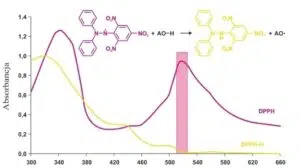
Figure 1: Chemical structure of the DPPH radical and UV-Vis spectra before and after reaction with an antioxidant substance (Wavelength [nm]) [7].
Fig. 1. Chemical structure of the DPPH radical and UV-Vis spectra before and after reaction with an antioxidant substance [7]. The reduction was carried out using a stable nitrogen radical, causing a decrease in the absorbance of the active substances contained in the tested samples. The DPPH• radical in solutions took on a purple color, which changed as a result of its reaction with the tested active substances. The degree of color change of the DPPH solution after adding a solution containing active ingredients, mainly oxyresveratrol, is a measure of their ability to scavenge free radicals. The absorbance of the solution was measured at a wavelength of λ = 517 nm. The DPPH• radical, in reaction with a substance that can give up hydrogen, creates a reduced form of DPPH•, which is formed in the solution and is a measure of the ability of antioxidants to neutralize free radicals [7]. Alcoholic DPPH solution. prepared by dissolving 2.8 mg of DPPH• radical. (M=394.32 g/mol) in 100 ml of methanol, then its absorbance was read (control sample). The solution was stored in a room protected from light. Cosmetics were tested. Preparation of samples containing antioxidants – 1 gram of cream was extracted with methanol in a separator, then stirred rapidly for about 5 minutes. The extract was then filtered using a Büchner funnel and stored in a dark place. To 3 ml of DPPH solution, 2 ml of previously prepared extract was added. The whole thing was heated in a water bath at 37°C for 30 minutes. The absorbance was measured from the initiation of the reaction for 30 minutes using a UV-Vis spectrophotometer. The results were presented using the percentage of free radical quenching calculated according to the formula:
% Inhibition = 100 (A0-A1) / A0
Where,
A0 – absorbance of the DPPH radical solution after 30 minutes without the addition of active substances.
A1 – absorbance of the DPPH radical solution after 30 minutes in the presence of the tested active substances [7].
Results
As mentioned in this article, 20 probands who were qualified for the study, in the first stage, biophysical parameters were tested and then they were treated with the use of manufactured cosmetics. The skin of the selected participant before and after the treatment is shown below (Fig. 2).

Figure 2: A: Photo of the proband’s skin before the procedure; B: Photo of the skin after peeling; C: Photo of the skin after the entire R-OXY treatment.
In order for the stratum corneum to perform its functions properly, proper skin care is necessary. It is important to regularly remove the layer of dead cells and maintain the appropriate pH of the skin. Based on the treatment performed, it can be concluded that dead epidermal cells have been removed. The skin was visibly cleansed of all impurities. The aim of the treatment was to facilitate the transport of care substances applied to the skin surface, unclog skin pores, ensure an appropriate level of skin hydration and optimal conditions allowing skin cells to rebuild and renew themselves.
The measurement results using the POLDERMA EXPLORE 3D skin analyzer and the MPA 580 Courage + Khazaka electronic GmbH probe set are presented below. The measurements were performed before the start of the study and lasted for 6 weeks. All people who started the experiment completed it. During the zero trial, the subjects did not use antioxidant care or protective filters.
The Level of Hydration of the Epidermis
The graph below shows the change in the value of the probands’ hydration level. It should be remembered that the subjects (n=20), apart from the zero sample, were subjected to the application of antioxidant care, filters and excessive solar radiation (Fig. 3). The results were averaged. All measurements were carried out on the cheeks and T zone for a period of 6 weeks.

Figure 3: Average change in the hydration value of probands performed during the study (n=20), * – p<0.05.
Based on the above graph, it can be seen that all people who participated in the study had better results in the hydration parameter as the experiment progressed. Based on the results presented in Chart 1, it can be seen that the skin is a complex mechanism and, despite negative factors, it spontaneously tries to restore the proper biophysical parameters of the skin. The time needed to restore appropriate parameters would be much longer if it were not for the antioxidant care used. Changes in the hydration parameter ranged on average from 23-70 [IU]. Table 1 presents the interpretation of the results. The longer the duration of use of the antioxidant series, the better the parameter improved.
|
The Degree of Hydration of the Epidermis |
Measurement Result [unit] |
|
Very dry skin |
<30 |
|
Dry skin |
30-45 |
|
The skin is sufficiently moisturized |
>45 |
Table 1: Interpretation of epidermal hydration measurement results.
Measurement of Transepidermal Water Loss
The graph below shows the change in the value of transepidermal water loss of probands. It should be remembered that the subjects (n=20), apart from the zero sample, were subjected to the application of antioxidant care, filters and excessive solar radiation (Fig. 4). The results were averaged. All measurements were carried out on the cheeks and T-zone for a period of 6 weeks.
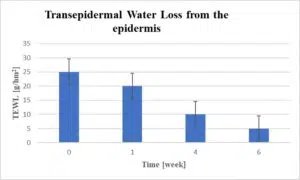
Figure 4: Average change in TEWL values of probands performed during the study (n=20), * – p<0.05.
Based on Table number 2, the test results can be interpreted.
|
Interpretation of the Results |
TEWL Value [g/hm2] |
|
Very healthy skin |
0-10 |
|
Healthy skin |
10-15 |
|
Normal skin |
15-25 |
|
Leather in poor condition |
25-30 |
|
The skin is in critical condition |
˃ 30 |
Table 2: The interpretation of the results of the epidermal TEWL level is as follows.
Based on the next graph showing changes in TEWL values of probands exposed to dry/hot air for several hours with the use of SPF 50 or 30 and antioxidant care improved (n=20). The value of transepidermal water loss decreased, which indicates proper water loss. Changes in the transepidermal water loss parameter ranged on average in the range of 25-5 [g/hm2]. The longer the duration of use of the antioxidant series, the better the parameter improved.
Level of Flexibility
The chart below shows the change in the probands’ elasticity values. It should be remembered that the subjects (n=20), apart from the zero sample, were subjected to the application of antioxidant care, products with a protective filter and excessive solar radiation (Fig. 5). The results were averaged. All measurements were carried out on the cheeks and T-zone for a period of 6 weeks.

Figure 5: Average change in the probands’ flexibility values performed during the tests (n=20), * – p<0.05.
Studies measuring the elasticity of the probands’ skin confirmed that the use of a combination of cosmetics with a filter and antioxidant care, despite the influence of hot air on the probands’ skin, increases the value of this parameter. The skin elasticity parameter of the respondents oscillated on average from 0.50 to 1.00 [mu]. The interpretation of the results of the level of epidermal elasticity is as follows: skin elasticity coefficient – the closer this value approaches 1 (100%), the more elastic the skin is measuring the level of lubrication. The graph below shows the change in the skin lubrication value of the test subjects. It should be remembered that the respondents (n = 20), apart from the zero sample, were subjected to the use of antioxidant care, products with a filter and excessive solar radiation (Fig. 6). The results were averaged. All measurements were carried out on the cheeks and T-zone for a period of 6 weeks.

Figure 6: Average change in the sebum value of probands during the study (n=20), * – p<0.05.
Dry skin, which the test subjects had after staying in excessively dry/hot conditions, reacts very strongly to environmental factors. Due to these conditions, the sebaceous glands of the probands stopped producing the appropriate amount of sebum needed for proper lubrication. Dry skin was also the result of a deficiency and a change in the amount of ingredients contained in sebum. It is the lipids and properly secreted sebum that protect the skin against external factors. When the sebum level is too low, the skin is more exposed to aggressive external factors. After regular use of the antioxidant series, sebum level results improved. The above assumption is confirmed by chart number 4. The average value of the tested parameter ranged from 3 to 7 [mu]. Depending on the duration of the experience (Table 3).
|
|
Measurement Result [j.u.] |
|
Dry low |
0 – 6 |
|
Normal |
˃ 6 |
|
Fat |
… |
Table 3: The interpretation of sebum level results.
pH Value Measurement
The graph below shows the change in the pH value of the probands. It should be remembered that the subjects (n=20), apart from the zero sample, were subjected to the use of antioxidant care, cosmetics with a filter and excessive solar radiation (Fig. 7). The results were averaged. All measurements were carried out on the cheeks and T-zone for a period of 6 weeks. This measurement was one of the most important parameters.

Figure 7: Average change in the pH value of probands performed during the study (n=20), * – p<0.05.
The normal pH value for an adult is 5.4-5.9 [IU]. As can be seen in Chart 5, the pH value of the probands ranged from 6.9 to 5.5 [IU]. The longer the subjects stayed in extremely dry/hot air, the higher this value increased. An alkaline pH value is a negative symptom indicating that proper functioning is impaired. However, after the application of the antioxidant series, it can be seen that the influence of acidic active substances caused a decrease in the tested value. Research was also carried out to measure the pH value after applying the cosmetic with a filter alone, without synergy with antioxidant care. The results are presented below. Fig. 8 Average change in the pH value of probands performed during the study (n=20), * – p<0.05.
The normal pH value for an adult is 5.4-5.9 [IU]. As can be seen in Chart 5, the pH value of the probands ranged from 6.9 to 5.5 [IU]. The longer the subjects stayed in extremely dry/hot air, the higher this value increased. An alkaline pH value is a negative symptom indicating that proper functioning is impaired. However, after the application of the antioxidant series, it can be seen that the influence of acidic active substances caused a decrease in the tested value. Research was also carried out to measure the pH value after applying the cosmetic with a filter alone, without synergy with antioxidant care. The results are presented below.

Figure 8: Average change in the pH value of probands performed during the study (n=20), * – p<0.05.
Based on the study, it can be concluded that the application of photoprotective cosmetics alone without combining them with antioxidant care increases the pH value. As already mentioned, a long-term increase in the tested value is a negative symptom indicating a disturbance in proper functioning.
Real Conditions
Then, the probands were subjected to 8 hours of physical activity in full sunlight. In the first stage, the research was conducted during week-long trips abroad. In the second stage, the subjects stayed in strongly sunny places for up to 6 weeks. Daily care consisted of applying SOD-C serum and cream in the morning, the main active substances of which are 3-0 ethyl ascorbic acid 20%, superoxide dismutase, glutathione, lipid complex 22, hydroxyapatite and 5% urea. When staying in a place with high sunlight, it was necessary to apply a cosmetic with an SPF 50 or 30 filter, selected individually depending on the needs and phototype of the test subjects. It was suggested not to apply excessive amounts of photoprotective products unless you are in direct sunlight. After intense activity of the probands, the R-OXY serum and cream were used in the evening in the area exposed to ultraviolet radiation, the main ingredients of which are: oxyresveratrol, 10% 3-0 ethyl ascorbic acid, shikimic acid, kojic acid, arbutin, acetylglycyl beta alanine, tranexamic acid, azeloglycine. Of course, you should remember to properly cleanse your skin with a cosmetic containing mild surfactants and a tonic. The task of the toner is to restore the appropriate pH value of our skin.
Below are photos taken of individual test subjects before and after a period of exposure to excessive solar radiation. In the meantime, the test subjects applied antioxidant care together with a protective filter SPF 30 or 50 (Fig. 9-11).

Figure 9: A: The proband’s skin before application and skin exposure to radiation; B: The skin after application and exposure to radiation.
Below is a list of photos taken before and after exposure to solar radiation.

Figure 10: A: The proband’s skin before application and skin exposure to radiation. B) The skin after application and exposure to radiation.
Below is a list of photos taken before and after exposure to solar radiation.

Figure 11: A: The proband’s skin before application and skin exposure to radiation; B: The skin after application and exposure to radiation.
Based on the study, no erythema or side effects of the application of the above-mentioned cosmetics were observed in full sunlight. You can notice that the skin is sufficiently protected against the negative effects of solar radiation. Measurement of the ability to quench the 1,1-diphenyl-2-picrylhydrazyl free radical by active substances contained in self-produced cosmetics. The % Inhibition of the oxidation reaction was calculated for the tested series (SOD-C and R-OXY), the results are presented below (Fig. 12).

Figure 12: The ability to study antioxidants in counteracting oxidation reactions.
R-OXY serum counteracts the oxidation reaction by 56%, SOD-C serum by 76% and vitamin C by 96%.
R-OXY serum counteracts the oxidation reaction by 56%, SOD-C serum by 76% and vitamin C by 96%. Based on the above results, it can be concluded that vitamin C at a concentration of 2% has the greatest ability to counteract the oxidation reaction. R-OXY brightening serum has been tested to counteract oxidation reactions and inhibit tyrosinase activity. The serum is based on a specialized brightening, antioxidant and exfoliating complex. It contains active ingredients such as oxyresveratrol, vitamin C, shikimic acid, arbutin and kojic acid (Fig. 13).
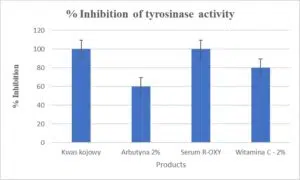
Figure 13: The influence of the tested substances on tyrosinase activity.
A 2% concentration of arbutin counteracts tyrosinase activity by 64%. 2% vitamin C has 84% inhibitory effect on tyrosinase activity. 1% kojic acid and R-OXY serum counteract tyrosinase activity 100%.
Discussion
This article presents research confirming the synergistic effect of cosmetics with a filter and antioxidant care in real conditions.
Based on the measurement of biophysical parameters of hydration, transepidermal water loss, elasticity, sebum level and, above all, measurement of pH values measured with the participation of the MPA 580 Courage + Khazaka electronic GmbH probe team and a multidimensional 3D skin analyzer. Polderma Explore 3D confirmed the beneficial effect of the tested antioxidant series in combination with a photoprotective product. The results confirm how important the synergy of antioxidant products combined with a sun protection product is.
Based on application tests (in-vivo), which were carried out on the skin of volunteers, the effectiveness of combining cosmetics with filters with antioxidant care was confirmed. A group of 20 people underwent the R-OXY treatment and then stayed in high sunlight (30 – 35°C). For a week, the tested group rode a bicycle for 8 hours a day, staying in full sunlight all the time. The patients spent the next five weeks actively exposing their bodies to excess every day insolation. It should be remembered that the skin of people starting the study was not tanned after the winter period. The R-OXY treatment was the first step in preparation for exposing the body to excessive radiation. Antioxidant care and cosmetics with filters were the second stage of preparing the skin for traveling to sunnier regions and enjoying physical activity outdoors. Before starting the experiment, the people participating in the study underwent the R-OXY treatment at the Dermatology Center. Based on application tests measured in the first week and in the last test, the following changes were noted in terms of the degree of hydration, elasticity, transepidermal water loss, lubrication and pH value [8].
Based on the results obtained, it can be seen that all people who participated in the study had better results in the hydration parameter over the course of the experiment, despite the subjects’ exposure to excessive amounts of sunlight. It can be noticed that in the period between staying in the tested hot air conditions and staying outside them, the hydro-lipid barrier was able to rebuild itself. Unfortunately, the longer we expose the volunteers to excessive dry air, the longer the protective barrier of our skin will regenerate and will not be able to perform their role correctly.
The hydrolipid coat, which is the basic protection of the skin, is weakened under the influence of hot air and is no longer able to perform its functions properly. Therefore, remember to sufficiently moisturize the skin by using antioxidant products. These products strengthen the barrier that inhibits water loss. The reduction in water evaporation from the epidermis is directly related to the increase in its hydration. The following compounds may be responsible for improving this parameter in the tested cosmetics. The recipe uses superoxide dismutase, an enzyme that neutralizes free radicals to protect DNA. In cosmetics, it is intended to protect epidermal cells during intense oxidative stress such as physical exercise, UV radiation and aesthetic medicine treatments involving skin exfoliation. Vitamin B3 – niacinamide regulates the proper composition of sebum, thus reducing seborrhea and preventing the skin from glowing. Urea 5% – a component of NMF (natural moisturizing factor in the skin) necessary for proper keratinization and maintaining the proper level of hydration of the epidermis. D – Panthenol accelerates healing, soothes irritations, burns and allergies and moisturizes [9].
The next measured parameter is, as already mentioned, connected to the hydration parameter. Test subjects who underwent TEWL measurement after contact with hot air, but who applied appropriately selected photoprotective creams and antioxidant care, were characterized by appropriate values of transepidermal water loss from the skin. The skin was healthy in all subjects. Vitamin E, an essential antioxidant, was responsible for maintaining the correct TEWL value. This compound prevents the oxidation of lipids in epidermal cells and intercellular cement.
Based on the studies on skin elasticity and hydration parameters, similar conclusions can be drawn – that synergistically selected care, despite patients’ exposure to sunlight for several hours, did not negatively affect the tested parameters. The skin did not become oily, this process was influenced by the combination of niacinamide, kojic acid and ferulic acid, which regulate the proper composition of sebum. They reduce seborrhea and prevent skin shine. In addition to lightening discolorations, tranexamic acid has special anti-itching properties and soothes skin inflammation and even allergic hives.
The most important of the tested parameters was the skin pH value. These parameters were measured before the measurements began, then after applying the photoprotective cream and after applying the entire antioxidant series. Very important conclusions were drawn. The pH value of the epidermis is influenced by endogenous and exogenous factors, such as: too high and low temperature, phospholipase A2, NMF components, components of sweat, sebum, bacterial metabolites, organic and inorganic chemical compounds applied to the skin. The efficiency of the epidermal barrier is also determined by the presence of serine and cysteine proteases in the stratum corneum. Proper exfoliation of the epidermis depends on the breakdown of proteins within corneodesmosomes, where serine proteases also regulate the synthesis of stratum corneum lipids. The correct pH of the skin is extremely important to keep it in good condition. Both too acidic and too alkaline pH affects the dysregulation of processes occurring in it and disruption of barrier functions. If the pH value of the facial skin is too low, it begins to produce more sebum, which may result in the skin becoming greasy, blackheads and imperfections appearing. Conversely, if the pH is alkaline, the skin becomes dry and prone to irritation. Please remember that the overuse of creams that protect the skin against excessive solar radiation causes the pH value to change to alkaline. That is why it is so important to apply these cosmetics in high sunlight conditions, when they should actually protect human skin against harmful radiation. Research has shown that after applying photoprotective creams, the skin’s pH value increases, which is why a holistic combination of photoprotection with antioxidant care, which lowers this value, is so important. It has been observed that the pH value of our skin is adequate. Raising the skin’s pH value above 6.0 causes damage to the hydrolipid barrier for up to 6 hours after application, before the pH returns to its natural value below 5.0 on average. Skin with a pH below 5.0 has been shown to be in better condition than skin with a pH above 5.0, as indicated by measuring the biophysical parameters of barrier function, hydration and elasticity. The effect of pH on the adhesion of resident skin microflora was also assessed; an acidic skin pH (4.0 – 4.5) maintains the existing bacterial flora attached to the skin, while an alkaline pH (8.0 – 9.0) promotes its spread from the skin [9]. To sum up, the use of filters in combination with preliminary care in the form of a treatment aimed at lowering the pH value of the epidermis and the application of an anti-oxidant series effectively protects against an overdose of sunlight, even during 8 hours of exercise in full sun. The presented results were achieved mainly thanks to the antioxidants used, whose ability to counteract oxidation reactions has been proven. The study used a combination of the following antioxidants. Based on the results of the tested substances, it can be concluded that kojic acid 1% and R-OXY serum have the strongest effect because they inhibit tyrosinase activity by 100%. Among the tested substances, 2% arbutin had the weakest inhibitory effect on tyrosinase activity. Tyrosinase activity inhibition tests can significantly contribute to demonstrating the quality of a cosmetic product’s performance by verifying the beneficial effect on the entire cosmetic. The above studies confirm the product’s ability to inhibit tyrosinase. The active substances contained in the serum contribute to skin brightening and reduction of discoloration. Daily systematic care with products with proven effects on the melanogenesis process is effective in maintaining good skin condition. Oxyresveratrol, which is an innovative derivative of resveratrol with a strong brightening effect and eliminating free radicals, protects the skin against photoaging and increases the resistance of cells to harmful environmental conditions [10]. Vitamin C (3-0 ethyl ascorbic acid) is the newest form of vitamin C used in cosmetics. It is characterized by high durability and biocompatibility with the skin. The presence of vitamin C in the cream complements its deficiencies in the epidermis, thus supporting natural antioxidant processes that protect valuable lipids against oxidation. This process involves the regeneration of naturally occurring vitamin E, which is necessary to maintain the proper lipid barrier of the skin exposed to excessive sun exposure. Shikimic acid has strong antioxidant, exfoliating and regenerative properties, slowing down the skin aging process. Protects against the negative effects of solar radiation and air pollution. Kojic acid – reduces pigmentation spots, brightens skin tone and fights discoloration. It has antibacterial, antifungal and antioxidant properties.
However, ferulic acid ester is characterized by antioxidant, soothing and antibacterial properties. The recipe uses superoxide dismutase, an enzyme that neutralizes free radicals to protect DNA. In cosmetics, it is intended to protect epidermal cells during intense oxidative stress such as physical exercise, UV radiation and aesthetic medicine treatments involving skin exfoliation. Vitamin E – an essential antioxidant that prevents the oxidation of lipids in epidermal cells and intercellular cement.
Conclusion
To sum up, the conducted research confirmed the assumptions that effective, non-invasive protection against the negative effects of solar radiation can only be achieved by combining sun protection with the application of antioxidant products that improve the biophysical parameters of the skin, regardless of the conditions to which the subjects were exposed.
Conflicts of Interests
The authors declare that there is no conflict of interest for this paper.
Funding
This research received no external funding.
Ethical Statement
Institutional Review Board Statement: Bioethics Committee consent, resolution number 692/23 (Ethical Approval and Consent to participate and Human Ethics).
Informed Consent Statement
Not applicable.
Data Availability Statement
The data presented in this study are available on request from the corresponding author.
Acknowledgments
Support from University of Education and Therapy and Symbiosis Laboratory is acknowledged.
Author Contributions
Conceptualization, J.I.-K.; methodology, J.I.-K. and E.K.-P.; software, J.I.-K., E.K.-P. and M.S.; validation: J.I.-K. and E.K.-P.; formal analysis, J.I.-K.; investigation, J.I.-K.; resources, J.I.-K., E.K.-P. and M.S..; data curation, J.I.-K.; visualization, J.I.-K.; supervision, E.K.-P. and M.S..; project administration, J.I.-K.; writing-original draft preparation, J.I.-K.; writing-review and editing, J.I.-K., E.K.-P. and M.S. All authors have read and agreed to the published version of the manuscript.
References
- Miller AJ, Tsao H. New insights into pigmentary pathways and skin cancer. British J Dermatol. 2010;162(1):22-8.
- Janda M, Green AC. Reliability of computer image analysis of pigmented skin lesions of Australian adolescents. Cancer. 2010;2:252-7.
- Antolovich M, Prenzler PD, Patsalides E, McDonald S, Robards K. Methods for testing antioxidant activity. Analyst. 2002;127(1):183-98.
- https://www.venus-beauty.com.pl [Last accessed on: April 15, 2024].
- Darlenski R, Sassning S, Tsankov N, Fluhr JW. Non-invasive in-vivo methods for investigation of the skin barrier physical properties. Eur J Pharm Biopharm. 2009;72(2):295-303.
- Brand-Williams W, Cuvelier ME, Berset CL. Use of a free radical method to evaluate antioxidant activity. LWT-Food Science and Technology. 1995;28(1):25-30.
- Zieliński H., Kozłowska H. Superoxide scavenging activity of cereal grains before and after hydrothermal processing. Pol J Food Nutr Sci. 2000;9:85-90.
- Igielska-Kalwat J, Gościańska J, Nowak I. Carotenoids as natural antioxidants. Adv Hygiene and Experiment Med. 2015;69:418-28.
- Igielska-Kalwat J, Gościańska J, Witkowska B, Nowak I. In-vivo studies of substances used in the cosmetic industry. Adv Dermatol Allergol. 2016;33(3):163-9.
- Igielska-Kalwat J, Firlej M, Lewandowska A, Biedziak B. In-vivo studies of resveratrol contained in cosmetic emulsions. Acta Biochimica Polonica. 2019;66(3):371-4.
Article Type
Case Report
Publication History
Received Date: 01-04-2024
Accepted Date: 15-04-2024
Published Date: 24-04-2024
Copyright© 2024 by Igielska-Kalwat J, et al. All rights reserved. This is an open access article distributed under the terms of the Creative Commons Attribution License, which permits unrestricted use, distribution, and reproduction in any medium, provided the original author and source are credited.
Citation: Igielska-Kalwat J, et al. In-vivo Studies of Cosmetics with Ultraviolet Light Filter and Synergistic Antioxidant Care. J Dermatol Res. 2024;5(1):1-15.
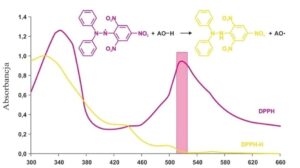
Figure 1: Chemical structure of the DPPH radical and UV-Vis spectra before and after reaction with an antioxidant substance (Wavelength [nm]) [7].

Figure 2: A: Photo of the proband’s skin before the procedure; B: Photo of the skin after peeling; C: Photo of the skin after the entire R-OXY treatment.
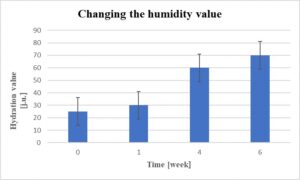
Figure 3: Average change in the hydration value of probands performed during the study (n=20), * – p<0.05.

Figure 4: Average change in TEWL values of probands performed during the study (n=20), * – p<0.05.

Figure 5: Average change in the probands’ flexibility values performed during the tests (n=20), * – p<0.05.
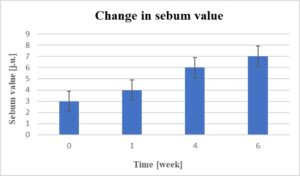
Figure 6: Average change in the sebum value of probands during the study (n=20), * – p<0.05.

Figure 7: Average change in the pH value of probands performed during the study (n=20), * – p<0.05.
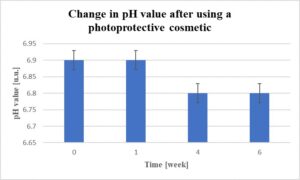
Figure 8: Average change in the pH value of probands performed during the study (n=20), * – p<0.05.

Figure 9: A: The proband’s skin before application and skin exposure to radiation; B: The skin after application and exposure to radiation.

Figure 10: A: The proband’s skin before application and skin exposure to radiation. B) The skin after application and exposure to radiation.

Figure 11: A: The proband’s skin before application and skin exposure to radiation; B: The skin after application and exposure to radiation.
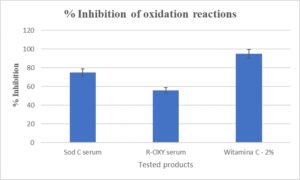
Figure 12: The ability to study antioxidants in counteracting oxidation reactions.

Figure 13: The influence of the tested substances on tyrosinase activity.
The Degree of Hydration of the Epidermis | Measurement Result [unit] |
Very dry skin | <30 |
Dry skin | 30-45 |
The skin is sufficiently moisturized | >45 |
Table 1: Interpretation of epidermal hydration measurement results.
Interpretation of the Results | TEWL Value [g/hm2] |
Very healthy skin | 0-10 |
Healthy skin | 10-15 |
Normal skin | 15-25 |
Leather in poor condition | 25-30 |
The skin is in critical condition | ˃ 30 |
Table 2: The interpretation of the results of the epidermal TEWL level is as follows.
| Measurement Result [j.u.] |
Dry low | 0 – 6 |
Normal | ˃ 6 |
Fat | … |
Table 3: The interpretation of sebum level results.


